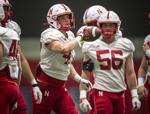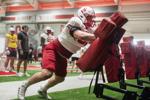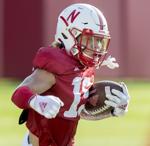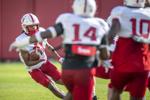Nineteen minutes into a two-hour interview, Nebraska athletics director Trev Alberts stated the obvious.
“I’m a little passionate about this.”
In this instance, “this” refers to conference realignment.
The former Butkus Award winner has only held this position for two full academic years while at his alma mater, but in that time there have been multiple seismic changes in the landscape of college athletics.
Conference realignment is only the latest chapter in this new era, and Alberts has enough thoughts on the matter to fill a doctoral dissertation.
Agree with him or not, he’s been through this before — albeit at a different level — when he navigated Nebraska-Omaha’s transition from Division II to Division I in 2011, putting the Mavericks in the Summit League.
People are also reading…
“History is unkind to conferences that have not had the courage to expand,” Alberts told the Journal Star four days after Oregon and Washington joined the Big Ten.
“I don’t believe it’s done. It’s never been done. It’s more likely than not that there will be continued periods of angst. I believe that the next go-around — that’s my basic conclusion — will be far more disruptive than anything we’re currently engaged in. We need to prepare ourselves mentally for that.”
A look back
How did we get here?
Simply put: TV dollars.
A 1984 Supreme Court case, NCAA v. Board of Regents of the University of Oklahoma, helped pave the way for conferences and independent schools to negotiate these TV deals, but it took a few years for substantial change to take root.
Back in Alberts’ playing days from 1990-93, money from ticket sales was still the meal ticket for financial success for most schools. But winds were shifting.
Notre Dame, in 1991, began its exclusive deal with NBC, and was the beginning of the end of the College Football Association, the group that had previously worked with schools to negotiate TV deals with networks. The SEC and the Big East signed a deal with CBS in 1996. The CFA ceased operations in 1997.
The cable bundle came along shortly thereafter, and so did an influx in cash.
Things were fine. For a while.
“What’s now happening is the cable bundle is in trouble through cord cutting,” Alberts said. “So where we were able to bundle all this stuff and where you would have certain teams that were joining conferences based on the cable bundle, now that’s being disrupted. So that business model is falling apart. And now it’s about streaming, so now the brand value of every individual institution is more important than ever before.”
The new Big Ten
Oregon and Washington jumped ship from the Pac-12 last week after the league had been “grossly mismanaged for over a decade,” per Pat Chun, Washington State’s athletic director.
When Oregon and Washington made their pitches to the Big Ten and the collection of the league’s athletic directors, presidents and chancellors took their vote, Alberts supported accepting the two Pac-12 powers.
“I thought adding Oregon and Washington made sense,” Alberts said. “Obviously we have a lot to work out in terms of scheduling, but I think the thing that was more palatable was the willingness of those schools to accept what their media value was for the seven-year period. And their history and investment in football and success and strength of the brands, I think it makes a lot of sense.”
What doesn’t make a lot of sense, though, is how it’ll work for sports that aren’t football — and Alberts concedes this point.
Since the news broke, a collection of Oregon’s softball players have taken their frustrations public. Having to go cross-country multiple times per season isn’t exactly a palatable thing, nor does it jibe with the Big Ten and NCAA’s message that student-athlete well-being and welfare are always top-of-mind.
“I think those concerns are valid and they’re real and they need to be addressed,” Alberts said. “I don’t think it’s sustainable. I will say, I think there’s some short-term strategies that we’re already working on with the Big Ten in ways that we can alleviate some of those concerns.”
But what about the long-term future?
Alberts proposes an ideal that’s more transformational than what’s currently happening — and it’s one I think will come to fruition someday. Maybe not exactly how Alberts envisions, but in some related version.
“This is my own personal opinion, but I think the future has to contemplate football being taken out of the mix,” Alberts said. “We’re moving to a 35 to 40 top brands being part of something. If you just look at football in isolation, eventually conferences will matter less in a sense. If we can find a way to take football and have that be this entity here, I think then you can get back to doing some much more intelligent thinking around the rest of the sports, which should be regionally based.
“All of these moves are driven by one sport. That’s football. And the football schedule is much different than a tennis schedule or a golf schedule. So these Olympic sports, the travel looks a little bit different. … We’re not there today, but I would think in the next 10 years, that reality makes more and more sense.”
Nebraska’s realignment
Alberts, obviously, wasn’t at his current post when Nebraska left the Big 12 for the greener pastures of the Big Ten back in 2011.
In hindsight, that decision appears more and more beneficial for Nebraska by the day.
“I thought at the time it was a good decision. You’re looking for stability,” Alberts said. “… The move to the Big Ten ensured we were part of the haves, like, we have the resource. It obviously did not guarantee us success.
“So, this is not about making sure that if you don’t have enough money, you can’t win. That’s not true. The Yankees don’t win the World Series every year. The Cowboys don’t win the Super Bowl every year. But (money) gives you a reasonable opportunity and, frankly, to fund the rest of your sports.”
Alberts continued.
“So, at the time the move to the Big Ten was 100% the right decision. Not only did it align us with aspirant academic institutions, but it ensured the resources necessary that the Athletic Department could be a viable solution. Again, receiving no state taxpayer dollars and no student fees. That has to continue being our strategy moving forward.”
I — as someone who is aligned with his thinking on realignment and as someone who is quite interested in this topic in particular — could have spoken to him for an more than hour on conference realignment alone.
In fact, I asked him three questions pertaining to conference realignment: his general thoughts on Big Ten expansion, travel concerns for sports other than football and his thoughts — looking back on Nebraska joining the Big Ten.
His thorough responses to those inquiries took 20 minutes.
His three-minute-long answer to that final question ended with this:
“I’m sorry. That’s the longest answer in the world.”
It is. It sure is.
But complicated situations call for thorough answers.
And lengthy columns.
Photos: Inside Nebraska's football practice, Aug. 8

Nebraska's Nash Hutmacher does drills during Tuesday's practice at Hawks Championship Center.

Nebraska's Gage Stenger tosses the ball during a football practice on Tuesday, Aug. 8, 2023, at Hawks Championship Center.

Nebraska's Chief Borders runs drills during a team practice on Tuesday at Hawks Championship Center.

Nebraska's Chief Borders (left) and Jacob Bower (right) run drills during a team practice on Tuesday, Aug. 8, 2023, at Hawks Championship Center.

Nebraska's Emmett Johnson returns the ball during a team practice on Tuesday, Aug. 8, 2023, at Hawks Championship Center.

Nebraska head coach Matt Rhule is seen during a team practice on Tuesday, Aug. 8, 2023, at Hawks Championship Center.

Nebraska's Ethan Nation returns the ball during a team practice on Tuesday, Aug. 8, 2023, at Hawks Championship Center.

Nebraska's Riley Van Poppel (left) and Leslie Black practice on Tuesday, Aug. 8, 2023, at Hawks Championship Center.

Nebraska's Bryce Benhart (left) and Brock Knutson practice on Tuesday, Aug. 8, 2023, at Hawks Championship Center.

Nebraska's Ty Robinson practices on Tuesday, Aug. 8, 2023, at Hawks Championship Center.

Nebraska special team coordinator Ed Foley coaches during a football practice on Tuesday, Aug. 8, 2023, at Hawks Championship Center.

Nebraska assistant coach Donovan Raiola speaks to players during a team practice on Tuesday, Aug. 8, 2023, at Hawks Championship Center.

Nebraska assistant coach Donovan Raiola speaks to players during a team practice on Tuesday, Aug. 8, 2023, at Hawks Championship Center.

Nebraska's Gunnar Gottula (left) and Grant Seagren practice a drill during a team practice on Tuesday, Aug. 8, 2023, at Hawks Championship Center.

Nebraska's Corey Collier practices on Tuesday, Aug. 8, 2023, at Hawks Championship Center.

Nebraska's Corey Collier practices on Tuesday, Aug. 8, 2023, at Hawks Championship Center.

Nebraska head coach Matt Rhule (left) talks with Nebraska assistant coach Evan Cooper during a football team practice on Tuesday at Hawks Championship Center.

Nebraska's Billy Kemp carries the ball during a team practice on Tuesday, Aug. 8, 2023, at Hawks Championship Center.

Nebraska head coach Matt Rhule is seen during a team practice on Tuesday, Aug. 8, 2023, at Hawks Championship Center.

Nebraska head coach Matt Rhule is seen during a team practice on Tuesday, Aug. 8, 2023, at Hawks Championship Center.

Nebraska's Ethan Nation picks up a return as assistant coach EJ Barthel looks on during a team practice on Tuesday, Aug. 8, 2023, at Hawks Championship Center.

Nebraska's Elliott Brown returns the ball during a team practice on Tuesday, Aug. 8, 2023, at Hawks Championship Center.

Nebraska's Isaiah Garcia-Castaneda returns the ball during a team practice on Tuesday, Aug. 8, 2023, at Hawks Championship Center.









